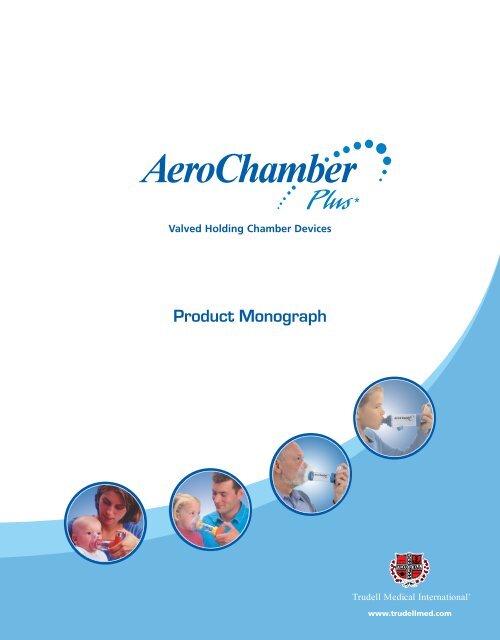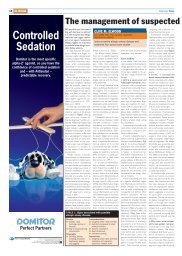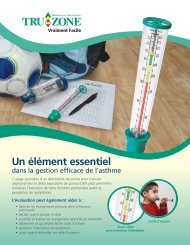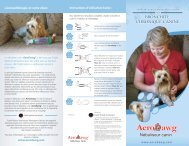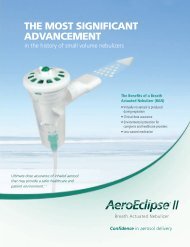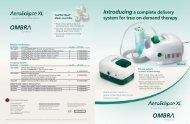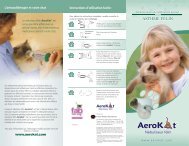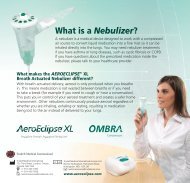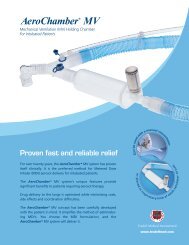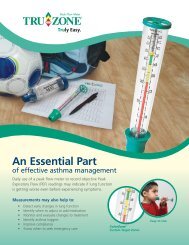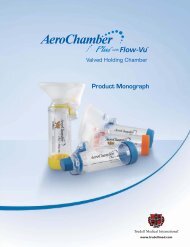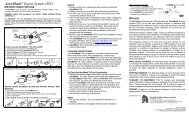AeroChamber Plus - Trudell Medical International
AeroChamber Plus - Trudell Medical International
AeroChamber Plus - Trudell Medical International
Create successful ePaper yourself
Turn your PDF publications into a flip-book with our unique Google optimized e-Paper software.
3Factors That Affect Aerosol Delivery From VHCsThree main factors affect aerosol delivery via a VHC: VHC characteristics, pMDI characteristics and thecharacteristics of the patient who uses the VHC.3.1 VHC CharacteristicsThe first generation of chambers, including GSK’s Volumatic † and AstraZeneca’s Nebuhaler † , were large volumedevices designed to accommodate the aerosol plume from CFC-formulated pMDIs. These plastic chambers wereconstructed of polycarbonate, a transparent material, which has been found to be prone to the accumulation ofelectrostatic charge. This accumulation of charge has been widely reported to cause aerosol to deposit on theinner surfaces of the VHC walls [Wildhaber, 1996; Dewsbury, 1996], reducing the fine particle mass availablefor inspiration. Although a ‘wash but don’t rinse’ procedure with ionic detergent has been shown to minimisethe build-up of electrostatic charge, the frequent washing suggested for maintenance of optimum VHCperformance may not be a practical expectation during routine clinical use. Thus, the variability in performanceof plastic VHCs may outweigh any small differences seen in the pharmaceutical performance between VHC devices.Some VHC devices such as Volumatic † incorporate heavy plastic one-way valves to prevent exhalation back intothe chamber. Patients with small lung volumes, such as infants, may not generate sufficient inspiratory flowrates to open these valves correctly [Kraemer, 1991; Barry, 1996b]. Modern small volume VHCs such as<strong>AeroChamber</strong> <strong>Plus</strong>* VHC with low resistance inspiratory valves may therefore be more appropriate for use ininfants and small children.The first truly portable, patient-friendly VHC was the <strong>AeroChamber</strong>* VHC which was developed at McMasterUniversity, Canada. It was designed to deliver the same lower respiratory tract dose of medication as the MDIalone when used under optimal conditions [Corr, 1982]. Since then new technologies and materials have becomeavailable and these too have been incorporated into the design of <strong>AeroChamber</strong>* VHC range. The<strong>AeroChamber</strong> <strong>Plus</strong>* VHC has incorporated aids such as the “EZ Flow” exhalation valve and theFLOWSIGnal* whistle, to assist appropriate inhalation patterns through the device. These VHCs are suppliedwith comfortable latex free ComfortSeal* facemasks for infants, children and adults to facilitate an effective sealbetween the VHC and face.3.2 pMDI CharacteristicsWhen a VHC is used in conjunction with a pMDI, it is important that the respirable mass of aerosol (i.e. theamount of the actuated dose that comprises particles small enough (
5.1.1 MethodologyIn vitro studies performed under controlled laboratory conditions are widely accepted as important in theevaluation of VHCs, by measuring the effect of the VHC on the fine particle fraction delivered by the pressurisedmetered dose inhaler (pMDI). Recent in vitro studies of GSK pMDIs by TMI’s aerosol laboratory have directlycompared the in vitro performance of the Volumatic † spacer with <strong>AeroChamber</strong> <strong>Plus</strong>* VHC using the AndersenCascade Impactor.The Andersen Cascade Impactor provides both a measure of the aerodynamic particle size distribution of thedrug particles in the discharged aerosol and also a measure of the fraction of the delivered dose which is withina size range suitable for deposition in the lungs. This fraction is defined as the fine particle mass and correspondsto the summed deposition of drug on stages 3, 4 and 5 of the impactor. Under the flow rate conditions of 28.3litres/minute, this deposition corresponds to material with an aerodynamic particle size range of 1.1 to 4.7 µm.The performance of each VHC was evaluated against the pMDI alone by assessing the effect of the VHC on boththe particle size distribution of drug in the aerosol and the fine particle mass. Each VHC was washed inaccordance with the patient instructions, prior to testing in order to minimise the effects of electrostatic charge.5.1.2 ResultsThe data [data on file, <strong>Trudell</strong> <strong>Medical</strong> <strong>International</strong>] demonstrate that for both the CFC and HFA products, eachof the Volumatic † and <strong>AeroChamber</strong> <strong>Plus</strong>* VHCs has no significant effect on the particle size distribution of thedrug in the aerosol, with the fine particle fraction consistently deposited on stages 3, 4 and 5 of the cascade impactor.These data demonstrate that each VHC gives an increase in the fine particle mass (FPM) compared to the pMDIalone. For GSK’s CFC products, Becotide † CFC and Becloforte † CFC, the magnitude of the percentage increasein FPM is comparable for each of the VHCs. Similarly, the increase in FPM observed for Serevent † CFC issimilar across the two VHCs. For GSK’s HFA products, Flixotide † HFA, Ventolin † HFA, Serevent † HFA andSeretide † HFA, the increase in FPM is of the same order for each VHC, although for Ventolin † HFA, Serevent †HFA and Seretide † HFA, the increase in FPM with <strong>AeroChamber</strong> <strong>Plus</strong>* VHC was lower than that with theVolumatic † chamber.This increase in fine particle mass observed in the laboratory for each of the VHCs is in accordance withexpectations and is due to the deceleration of the aerosol plume when discharged into the VHC. However,Volumatic † and <strong>AeroChamber</strong> <strong>Plus</strong>* VHC have been shown to give comparable performance. Although in afew cases statistically significant differences were detectable between the VHCs, driven largely by a smallstandard deviation, the practical differences between the VHCs for all of the products were small, and in noinstance exceeded 10% of the label claim dose.Other studies, which have compared the aerosol delivery in terms of respirable dose (or FPM) and Mass MedianAerodynamic Diameter (MMAD) of Ventolin † HFA, have shown equivalent delivery via GSK’s Volumatic † orBabyhaler † devices [Cripps, 1997] and between the <strong>AeroChamber</strong> <strong>Plus</strong>* VHC and OptiChamber † VHCs [Crim,2003]. Similar observations were made for Flovent † CFC delivered via <strong>AeroChamber</strong> <strong>Plus</strong>* VHC or Easivent †spacers compared to the MDI alone [Asmus, 2002]. With Becotide † , similar FPM recoveries were made fromVolumatic † and Babyhaler † , although for this CFC formulation, FPM was lower from the <strong>AeroChamber</strong>* VHC[Barry, 1996a].6 *
*725 Third Street,London, Ontario, Canada N5V 5G4Phone: 1-519-455-7060 Fax: 1-519-455-7858Email: customerservice@trudellmed.comwww.trudellmed.comAuthorised European Representative:<strong>Trudell</strong> <strong>Medical</strong> <strong>International</strong> Europe LimitedBioCity Nottingham, Pennyfoot StreetNottingham, NG1 1GF, UKPrinted in Canada. 10084-001 Rev A. * trade marks and registered trade marks of <strong>Trudell</strong> <strong>Medical</strong> <strong>International</strong>.†trade marks and registered trade marks of the respective companies. Copyright © <strong>Trudell</strong> <strong>Medical</strong> <strong>International</strong>2005. All rights reserved.ISO CLASS 8CLEANROOM MANUFACTURING


